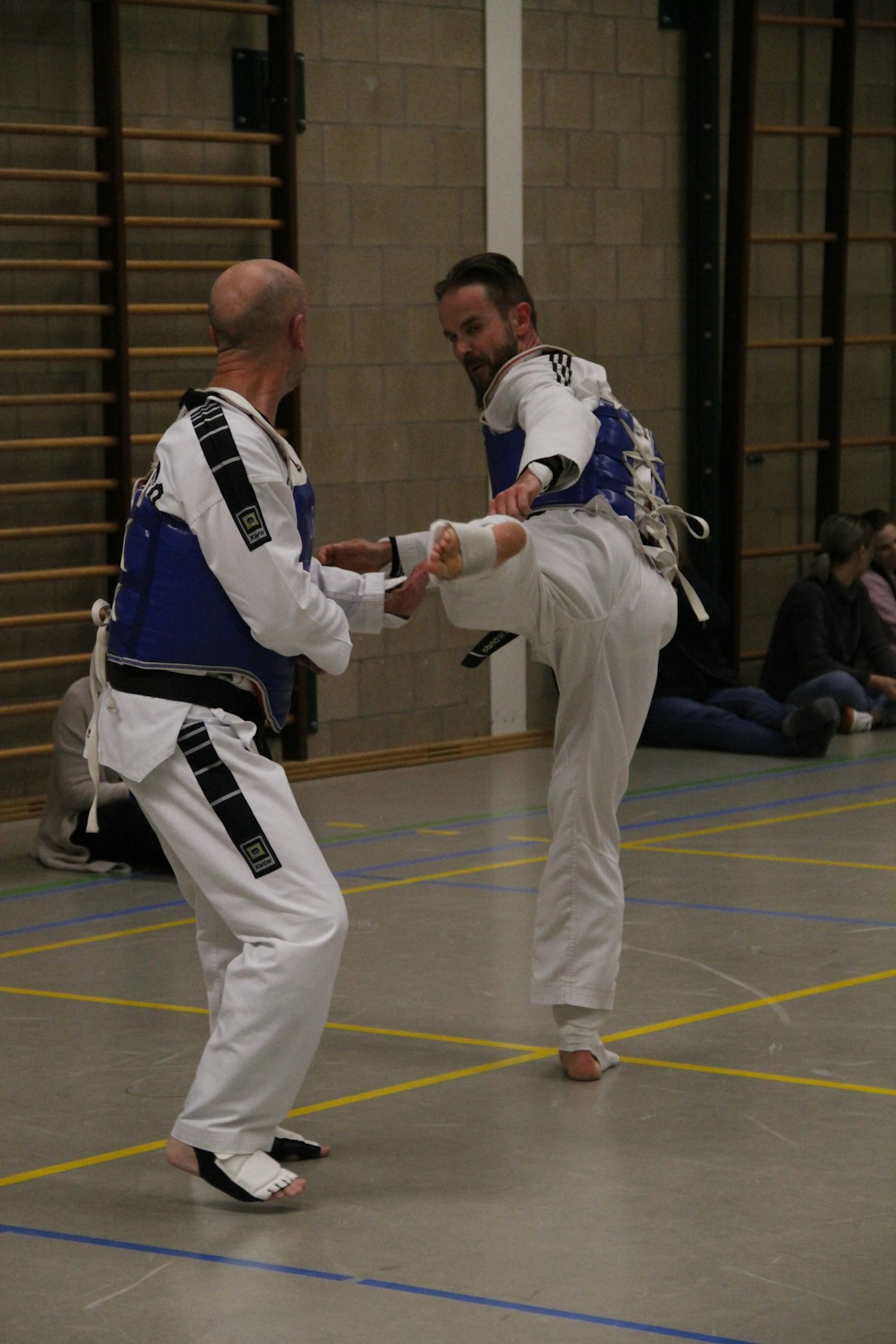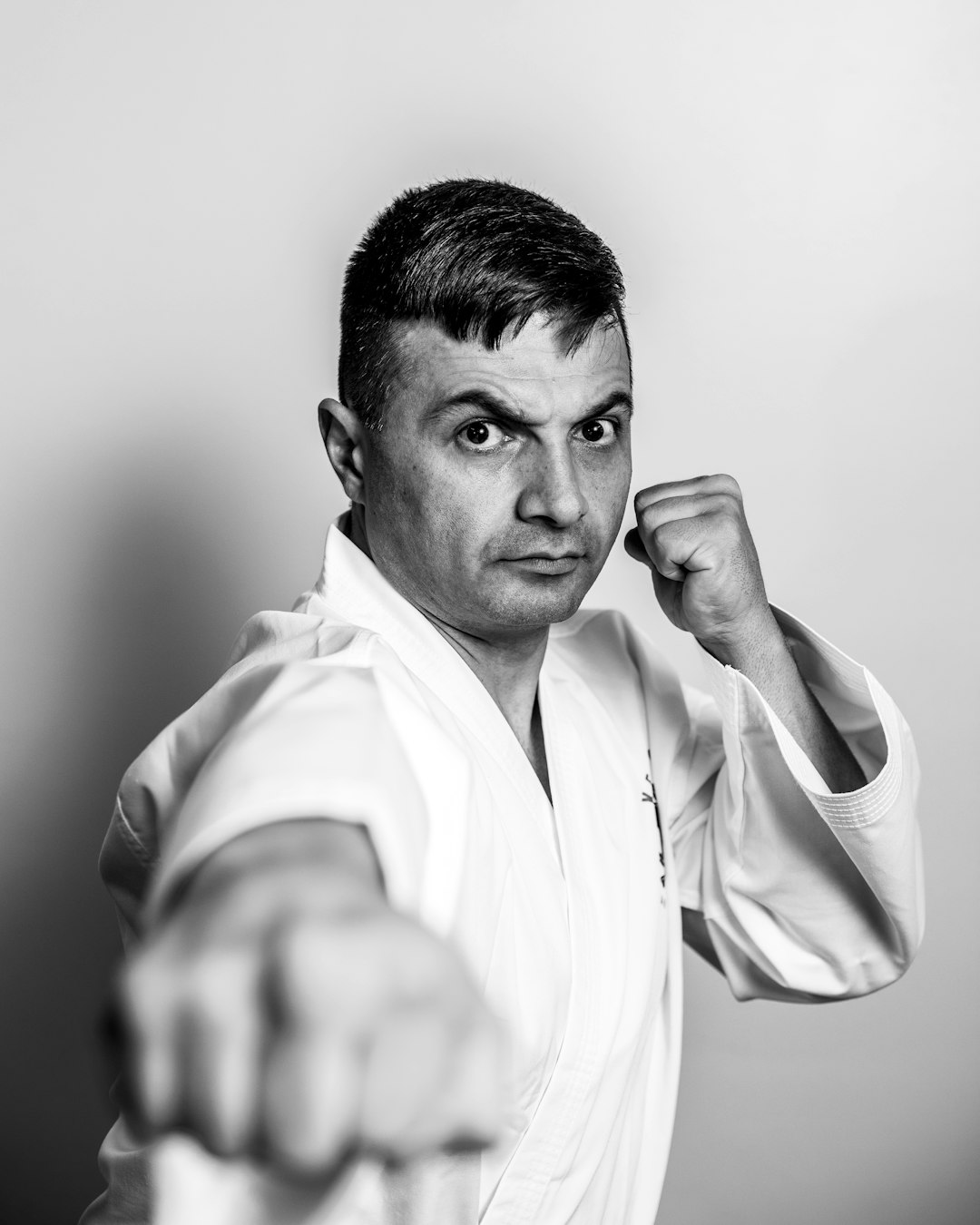The traditional karate attire known as the keikogi or gi is central to the practice of karate, serving both practical and symbolic purposes. It consists of a jacket, trousers, and belt, with the jacket featuring a closed collar and long sleeves for mobility, and the trousers being straight-legged for comfort and flexibility. The belt, known as an obi, not only holds the gi together but also indicates the wearer's rank within the karate discipline. The fabric of the gi is typically heavy cotton or hemp blend, chosen for its durability and breathability. Beyond its functional aspects, the keikogi embodies the respect and values inherent in martial arts traditions, including self-respect, mutual respect, and reverence for the art. Practitioners must select their karate outfit with care, considering both the requirements of their specific style and the need for proper maintenance post-training to ensure longevity and cleanliness. Proper care includes rinsing in cold water after each session, washing with a gentle detergent without bleach or high temperatures, and air drying to prevent shrinkage or distortion. Maintaining the karate outfit called keikogi is key to preserving its integrity and your performance on the mat.
Karate practitioners worldwide adhere to a time-honored tradition, donning a specific outfit that reflects their dedication and discipline. This article delves into the essence of the karate outfit, known as the keikogi, and its significance in the practice. We will explore its components, the evolution of karate gear beyond the traditional uniform, and offer guidance on selecting and maintaining your own karate outfit. Whether you’re a beginner or an experienced martial artist, understanding the intricacies of the keikogi is key to honoring the rich history of this revered martial art.
- Understanding the Traditional Karate Outfit: The Keikogi
- Components of a Keikogi: A Closer Look at the Karate Uniform
- Evolution and Variations in Karate Gear: Beyond the Basics
- Selecting and Maintaining Your Karate Outfit: Care and Considerations for Practitioners
Understanding the Traditional Karate Outfit: The Keikogi

When delving into the realm of traditional martial arts, one encounters a variety of garments that signify discipline and respect for the practice. Among these, the keikogi, often referred to as a karate outfit, holds significant importance. Known colloquially as a gi in some martial arts, the keikogi is a two-piece garment consisting of a jacket and trousers, designed to facilitate movement while providing a uniform appearance for practitioners. The top, a jacket with long sleeves, fastens up the center front with buttons, and the trousers are straight-legged, typically held up by belts indicating the wearer’s rank. But what exactly constitutes a keikogi, and why is it the preferred attire for karateka during training and formal occasions?
A keikogi is distinguished from other martial arts gi by its distinctive design features. It is characterized by its large, rounded collar, long sleeves with narrow cuffs, and an overall cut that allows for a full range of motion without being overly restrictive. The fabric, usually a heavy cotton or hemp blend, is both durable and breathable, making it suitable for the rigors of karate practice. Additionally, the keikogi often features a crest on the breast, representing the style of karate or the dojo where it is worn. Is the keikogi simply a uniform, or does it serve a deeper purpose within the traditions of karate? The answer lies in its origins and the values it symbolizes: respect for oneself, one’s training partners, and the art of karate itself.
Components of a Keikogi: A Closer Look at the Karate Uniform

When practitioners step onto the mat to practice karate, they don uniforms that are both practical and symbolic. The traditional karate outfit, known as a Keikogi, serves as a testament to the discipline’s rich history and is an integral part of the martial art experience. The Keikogi, which translates to ‘training clothes,’ is characterized by its simple, white cotton design. It consists of a jacket, trousers, and a belt, each with specific features that cater to the functionality and formality required during practice and competition.
The jacket of the Keikogi, or Uwagi, features a closed collar, long sleeves with short cuffs, and is designed to allow for full range of motion. It typically has five or six buttons down the front, with the top button traditionally left undone during practice. The trousers, known as Shuko, are straight-legged with a side split and are intended to be comfortable yet fitting enough not to hinder movement. The belt, or Obi, which is used in conjunction with the Keikogi, varies in color and width according to the practitioner’s rank and serves as a visual representation of their proficiency in karate.
Evolution and Variations in Karate Gear: Beyond the Basics

When delving into the realm of martial arts, one cannot overlook the significance of the attire that practitioners don. A karate outfit, commonly referred to as a gi, is more than just a uniform; it’s a tradition deeply rooted in the discipline’s history. Over time, the evolution and variations in karate gear have adapted to meet the needs of both traditionalists and modern practitioners. The classic karate outfit, known as the keikogi or simply gi, typically consists of a jacket and trousers made of cotton or hemp, traditionally white in color, symbolizing purity and humility. Does the traditional gi offer any practical advantages for training? Absolutely, its loose fit allows for ease of movement and its durability provides protection during practice.
Beyond the basic gi, there are distinct variations tailored to different styles and levels of expertise within karate. For instance, kyokushin karate, a style originating from Japan, often requires a thicker jacket that can withstand the rigors of kumite (sparring). On the other hand, shotokan karate, another major style, may have a lighter and less padded gi. Are there any additional elements to consider in a karate practitioner’s attire? Yes, accessories such as belts, known as obi, and hakama, which are divided skirts for advanced students, are also integral parts of the ensemble. These not only signify a practitioner’s rank but also enhance the functionality of their training by providing additional mobility and protection where needed. The evolution of karate gear reflects the sport’s ongoing adaptation to new challenges and the evolving needs of its practitioners.
Selecting and Maintaining Your Karate Outfit: Care and Considerations for Practitioners

When selecting a karate outfit, often referred to as a gi, it’s crucial to consider the style of karate you are practicing, as different styles may have specific requirements for their attire. For instance, Shotokan and Goju-ryu karate practitioners typically wear a white gi with straight legs, while other styles might allow for variations in color or cut. The jacket should fit comfortably without being too tight or too loose, allowing for a full range of motion during practice. The pants must also be tailored to prevent them from becoming entangled during movements. Additionally, the belt, or obi, which holds the gi closed, is an important element that signifies the wearer’s rank. It’s essential to ensure that your gi and belt conform to the standards set by your dojo or karate organization.
Maintaining your karate outfit involves regular care to keep it clean and in good condition. After each training session, it’s advisable to rinse your gi in cold water to remove any sweat or debris. Use a mild detergent for washing, and avoid bleach or high-temperature cycles, as these can damage the fabric and cause fading. Hanging the gi to dry is preferable to machine drying, which can shrink it or alter its shape. Proper care extends the life of your karate outfit and ensures that you present yourself in the best manner during practice or competition. Remember, a well-maintained gi not only looks better but also feels more comfortable on the mat.
In conclusion, the traditional karate outfit, known as a keikogi, is emblematic of the discipline and history that underpin the martial art. This article has delved into the essential elements of this garb, from its components to the variations found across different styles of karate. Practitioners will find that selecting the right keikogi goes beyond mere aesthetics; it’s a choice that reflects their commitment and respect for the art. Proper maintenance ensures the longevity and effectiveness of this fundamental piece of equipment, making it an indispensable tool in any karateka’s practice. Whether you are new to the martial art or a seasoned practitioner, understanding the significance of your karate outfit called will deepen your appreciation for the sport and its traditions.
